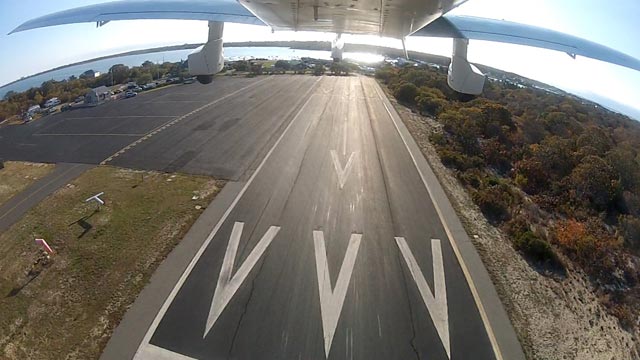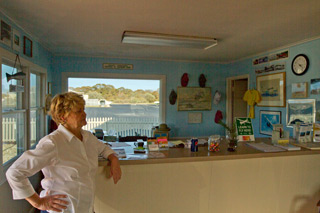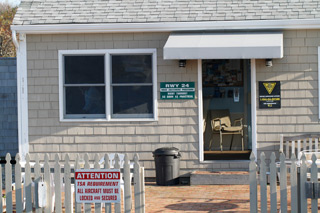
Montauk Airport is bound by a marina to the west, dunes and beach to the north and east, and marshland to the south.
The approach to Runway 24 demands attention and care to clear the narrow row of sand dunes separating pavement and beach. The rewards that await include surf casting, nearby restaurants selling seafood straight from the dock out back, and a quick cab ride into town, or local parks, or the historic Montauk Lighthouse.
Montauk Airport has beckoned pilots since Perry B. Duryea Jr. first carved out the runway in 1957, offering relatively Spartan services (there’s no fuel since the tanks came out years ago, and no maintenance facility) that do include showers, a flight planning station, and the smiling face of Helen Gil, who has managed the airport for years. The walls inside a tiny terminal building are covered with hundreds of photos Gil has taken, a mix of famous faces like Ray Charles (her favorite among celebrity visitors), interesting aircraft, and local pilots.
It is a place, Gil said, that everybody comes to love. Since late summer, it has been listed for sale, with an asking price of $18 million.
Timothy J. Griffin is both a pilot and agent for Prudential Douglas Elliman Real Estate, the firm handling the sale.
“As an aviator, you always want to keep it an airport,” Griffin said. “That, ideally, is what we want to find … someone with a passion for aviation. It’s got a ton of potential. It’s in great condition.”
 Helen Gil has managed Montauk Airport for years, and said local pilots hope a new owner will keep it going.
Helen Gil has managed Montauk Airport for years, and said local pilots hope a new owner will keep it going.
The FAA has granted $2.65 million to resurface the runway and make other improvements in recent years, and those grants required assurances that the airport would continue to operate as such until 2019. Pilots hope that will not be the end of the airport’s run, including Jeff Melagrano, who flew in from Westchester County Airport on a recent Friday afternoon to hop a cab downtown, a trip he has made regularly since 1978.
“It’s just a great place to relax, do nothing, and watch the ocean,” Melagrano said.
The ocean also draws fishermen who cast in the surf that rolls in gently at this entrance to Long Island Sound. A busy fishing port is literally across the street.
“It’s a great little fishing community, still,” Gil said. “Even though we’ve kind of been Hamptonized this year, you know? We’re not a Hampton.”
Griffin said the white sand beach, blue and green water, and a runway so close to both reminds him of Princess Juliana International Airport on St. Maarten, where jetliners sweep just a few feet over the beach. The water might be cooler, Griffin concedes, but the views can compare.
On an autumn day, with Gil preparing to close up shop for winter (the airport is staffed April-November, but open for year-round use), cattails, beach plums and blueberry bushes line the runway and taxiways, lending a burst of red and orange to the scene. Deer have become so abundant that hunters are occasionally invited to cull the herd, for safety. Turkeys occasionally walk around like they own the place, and seagulls use the tarmac to open lunch, dropping shellfish from high above to smash open shells that must be swept regularly. Gil said when she returns in April, the black pavement will be white with shell fragments.
 The tiny terminal building at Montauk Airport is open April to November, but the airport is open for year-round use.
The tiny terminal building at Montauk Airport is open April to November, but the airport is open for year-round use.
Nearby, there are vineyards, horseback riding, and the remains of a U.S. Air Force radar station, a dormant antenna that once stood watch over the eastern approach to New York.
For pilots, the airport can save hours of driving from New York City, Southern New England, and points beyond. A flight from Hartford, Conn., at 115 knots took little more than half an hour.
Griffin said Montauk’s 37 acres could ultimately yield six housing lots, though such a plan would have to wait until 2019.
There remains hope that new owners will value the airport for what it is. Gil said relations with the local community are excellent, enhanced by noise abatement procedures designed to keep the traffic pattern over water. AOPA Vice President of Airport Advocacy Bill Dunn said the airport is worth preserving.
“A community wouldn’t think of closing an on- or off-ramp from a roadway to their community—the same is true for a general aviation airport; it’s an entry way to the local community,” Dunn said.



